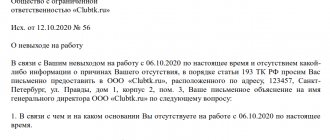Last modified: January 2021
Labor relations are not always smooth and comfortable for both parties – employer and employee. If certain conditions of the employment contract are not fulfilled, there is a desire to part with the violator. One of the options for unpleasant partings with an employee is dismissal for absenteeism. The administration’s position does not always seem justified, which gives a person the opportunity to challenge the decision and be forcibly reinstated.
To protect yourself from negative consequences, if you want to fire someone for absenteeism, you should understand the details of the process in more detail before using this basis for separation.
Definition of the concept
Article 81 of the Labor Code of the Russian Federation provides general explanations of what is considered absenteeism at work. To justify parting with an employee for absenteeism, you must have 2 important signs for which you can fire an employee:
- The employee did not provide valid reasons for absence.
- The period of stay outside the territory of the enterprise was from 4 hours, calculated in a row, or in total for a work shift.
Behind the clear formulation of what is dismissal under an article for absenteeism, there are a lot of nuances that must be clarified before dismissing a person, since subsequently a long absence may hide a fairly serious reason for missing work hours:
- There has been an accident;
- severe malaise occurred;
- circumstances did not allow leaving a minor who needed the help of an adult;
- the citizen participated in investigative actions, etc.
Since life is quite difficult to predict, there is no need to rush into dismissal for absenteeism. The employer is strongly recommended to adhere to the algorithm of actions prescribed by labor legislation, since quick actions are fraught with subsequent challenge and cancellation of the decision.
There is another reason to think about the applicability of the article. The law contains a link that allows you not to go to work if the administration has delayed the payment of wages for more than half a month (Article 142 of the Labor Code). An employee should take into account that thoughtlessly missing work hours, without warning management, often leads to a quick parting with a job and earnings, regardless of the person’s desires.
Thus, the main condition for dismissing a truant worker is the absence of compelling arguments to explain his absence from work.
Features of interpretation
Despite the clear definition, the parties have the opportunity to interpret differently the meaning of the definition and the circumstances surrounding dismissal. The fact is that the law does not clarify what is considered the workplace of a person employed at an enterprise. The workplace may be limited to a specific chair, or include an industrial building, the entire area within the fences of the enterprise.
To correctly decipher why they are fired from work under an article, they start from what is written:
- in the job description;
- in the employment agreement;
- collective agreement;
- internal documentation at the enterprise.
Often, the text of the job description determines the specifics of performing job duties related to location in a particular place. It is recommended to pay attention to the points relating to the description of the workplace (shop, machine, etc.) If it is stated that the worker is obliged to engage in work activities servicing a specific machine, any 4-hour period of time not at the machine gives grounds to consider the applicability of Article 81.
When the job description makes no mention of the exact location of the employee during working hours, the specifics of the work are not mentioned within the limits of local standards, then they proceed from the general provision of federal legislation, which considers the workplace as a territory where a person must appear to perform duties according to instructions and obligations according to agreement.
According to the law, the fact of a person’s four-hour absence from work must be recorded, otherwise the manager will not be able to prove the existence of legal grounds for terminating the contract. If an employee was absent for less than 4 hours, the administration has the right to punish the offender and reprimand him, but there will be no reason for dismissal.
As a consequence of this restriction, some careless workers use 4 hours, allowing them to be absent without any particular negative consequences.
When calculating time, it is important to note that 4 hours does not include work break time. According to Art. 108 of the Labor Code, working hours are recorded without lunch included. If an employee’s absence is recorded during the day, the maximum period of absence should be increased by the break time established at the enterprise.
Another important nuance that the manager must take into account when making a decision on the violator. The Labor Code does not require mandatory consecutive hours of absence. If an employee leaves work multiple times during a work shift or day, all these periods will be summed up. If work time was missed on different shifts or days, it is illegal to sum up the duration of absence, and counting how many absences lasting up to 4 hours was completely pointless.
The application of these provisions in practice means that if a person was absent from 9:01 to 13:00 and showed up at 14:00, the maximum risk of downtime is a reprimand. If the absence lasted a minute longer, the employer has the right to terminate the contract.
When determining how many absences can lead to dismissal under an article, you need to understand that only 240 minutes of missed work time is enough.
Features of the concept of “truancy”
Absence from work for 4 hours is considered absenteeism. At the end of today’s article, it would be useful to pay attention to all sorts of legislative subtleties and nuances of absenteeism. Of course, the main and most of the features of the concept have already been highlighted above, but there also remains a small part of them that have not been noted.
More precisely, we are talking about the following:
- Firstly, you should write a few words about forced absences. This combination of words in the Labor Code of the Russian Federation means that the employee did not show up to the workplace not through his own fault, but due to the carelessness of the employer or some natural disaster. The presence of such circumstances makes it impossible to dismiss a “truant” worker, so the adoption of even less significant punishments would be illegal here. Examples of forced absenteeism include a worker’s failure to show up for work due to his illegal transfer to another position, violations in the process of registering labor relations with the employer, and similar reasons.
- Second, let's look at less severe and more commonly used penalties for truancy. Today in the labor sphere of the Russian Federation, reprimands are most common in this regard. The procedure for presenting them to truant workers is completely similar to that described for dismissal, so its implementation usually does not cause any difficulties for anyone. Less often, instead of reprimands, deprivation of bonuses is used, if this is discussed in the employment contract, or similar forms of punishment.
- And thirdly, a few suggestions about whether it’s worth challenging dismissal for absenteeism. It all depends on the desires of the employee, his place of work and, most importantly, the fairness of the dismissal. If the latter was implemented completely legally, there is no point in suing the employer. In other cases, it is quite possible to try to fully or partially restore rights. Do you need it? Decide for yourself.
Which article governs dismissal under the article?
When a violation of labor discipline becomes obvious, and a person’s absence is determined to be unfounded, you should know under what article they are fired for absenteeism - paragraphs. “a” clause 6, part 1, article 81 of the Labor Code of the Russian Federation. The law does not require that the most severe punishment be applied, but it does provide grounds for dismissal of hired personnel. At the same time, there is no need to wait until there is a chance to get rid of the careless employee. In order to lose your job, 1 recorded absence is enough.
Labor Code of the Russian Federation Article 81. Termination of an employment contract at the initiative of the employer
Resolution of the Plenum of the Supreme Court of the Russian Federation dated March 17, 2004 N 2 (as amended on November 24, 2015) “On the application by the courts of the Russian Federation of the Labor Code of the Russian Federation”
The only reason to challenge harsh measures against an absent employee is to establish violations in the dismissal procedure and provide evidence in court that the absence was caused by compelling reasons permitted by law.
Special cases of dismissal for absenteeism
Not any absence from work will be counted as absenteeism. If an employee refuses to go to work on his day off, this will not be considered absenteeism. At each individual enterprise, there are exceptions under which people can be called back from vacation.
Information
A gross violation is the dismissal of a person who was in the hospital during the days he was absent. Even in a hurry, management is obliged to reinstate a dismissed person in the presence of a sick leave certificate, which is a supporting document. If information about illness is concealed, the judge may take the employer’s side.
Many organizations have repeatedly thought about this question: “Is it possible to fire a pregnant lady?” The answer to this question is clear: “No.” The Labor Code of the Russian Federation prohibits an employer from terminating an agreement concluded with a pregnant woman. If a pregnant woman allows herself to miss working days, she can only be fired upon liquidation of the enterprise. Other types of disciplinary sanctions can be applied to this category of employees: reprimands, reprimands.
Attention
Any delays in mandatory payments will result in the dismissed person filing a statement of claim to collect a fine from the employer for the delay in payments, as well as moral damages and legal costs. Such a claim is always satisfied, because the employee defends his rights in this case.
Employer's procedure
A record of dismissal under an article can seriously damage an employee’s track record. The main negative consequence for the employee is inevitable problems with new employment, since there are few people willing to hire a person who was irresponsible in their duties at the previous place of work. The new manager will definitely check under what article the applicant quit his previous job.
The manager who has decided to terminate the employment relationship must adhere to the registration procedure established by the provisions of the Labor Code. Regulations, according to Article 193 of the Labor Code of the Russian Federation:
- When establishing the fact of absence, it must be documented. The management orders that an act of absenteeism without good reason be drawn up, specifying specific hours and the date of the event, since dismissal under an article for absenteeism can only be done in strict compliance with the sequence.
- According to the provisions of State Standard No. R-6.30-2003 (clause 3.11 section 3), the act is drawn up on the day the violation is detected. Retroactive registration is not permitted.
- As soon as the employee appears at the workplace, he is given the drawn up act for review.
- In response to receiving the document, the employee will have to write an explanatory note clarifying the reasons why he was absent from work. 2 days are allotted for the preparation of this paper.
- If no explanations are provided, the enterprise administration prepares an act recording the refusal to provide explanations.
- Next, a report is drawn up addressed to the director describing the circumstances of the person’s absence. The report on absenteeism and an explanatory note (if any) are attached to the report.
- After considering the circumstances of the event, the management of the organization makes a decision on dismissal in compliance with the Labor Code and orders the issuance of an appropriate order.
- Art. 77, 80 Labor Code of the Russian Federation: grounds for dismissal of an employee
Since the reason for absenteeism may later turn out to be significant and the employee will require reinstatement, the manager must conduct an investigation and obtain confirmation that the employee did not have valid reasons for missing work time before terminating the contract or collecting a penalty for absenteeism. It is quite possible that the employee’s apartment was flooded, there was a fire, or there was a communications failure at home, which forced the person to be absent from work.
When an employee is absent for a long time
- Dismissal of a part-time worker: in what cases, procedure
As the Labor Code indicates, the employer’s algorithm of actions necessarily includes a stage of proceedings with the subordinate to find out the real reasons for the absence. However, if an employee disappears and stops going to work, compliance with the regulations is impossible.
The question arises whether it is easy to fire a person who has stopped showing up at the workplace, and how to proceed correctly.
The procedure for dismissal for absenteeism in a situation of long-term absence of a person includes:
- Preparation of an absenteeism report with information reflected in the time sheet.
- Issuing a written notice requesting the employee to appear and provide an explanation for his absence.
- Correspondence is sent to an address known to the HR department.
- The subordinate is given 2 days to provide comments, plus the period required for mail delivery.
- If the employee does not respond, the enterprise draws up an act establishing a refusal to provide explanations.
- The next stage is an additional investigation to clarify the circumstances of the person’s absence. The law does not require compliance with this stage, however, the information obtained at this moment will allow you to make the right decision, eliminating the risk of challenge and further reinstatement. Relatives will help to find out the causes of the incident if information about them is contained in the employee’s data.
- Drawing up an order and signing it by the head. The grounds for dismissal include an article for absenteeism.
- Due to the impossibility of familiarizing a person with the order, a corresponding act is drawn up.
- In the personnel department, they pick up the person’s work book and make a corresponding entry.
- The accounting department makes the final payment upon dismissal.
- A letter is sent to the employee’s postal address inviting him to come and pick up his work permit.
Due to the presence of time restrictions during which the employer’s right to apply disciplinary sanctions applies, the procedure should not be delayed for more than 1 month.
How to prove illegal dismissal?
Having received an unfair punishment from an employer, many citizens do not know what to do if they were fired for absenteeism and in what direction to act.
First of all, it is necessary to collect sufficient evidence that an illegal dismissal was committed. In this case, you can check the employer’s actions in two directions:
- How correctly the procedure for applying disciplinary sanctions was followed (Article 193 of the Labor Code).
- How correctly the dismissal procedure itself is formalized (Chapter 13 of the Labor Code).
Checking the fact of absence from work
According to current legislation, the employer must document the fact of a subordinate’s absence from work. For this purpose, an absence from work report is drawn up. This paper reflects the name and position of the offender, as well as the date and time during which he was absent.
In order for the act to have legal force, the employer must comply with the following requirements :
- The document must contain the signatures of several witnesses (company employees).
- A report is drawn up for each missed day or week (if the subordinate does not appear for a long time).
- Failure to appear must be recorded no later than 1 month after the violation.
- The employer must familiarize the offender with the act against signature.
- If a subordinate refuses to sign, then a record of this must be made in the document.
Let's learn how to set a dismissal date for absenteeism by reading this article.
Thus, verification of the fact of absence from work is carried out by requesting the corresponding act. If the employer did not prepare such a document or did it with violations, then the dismissed person can easily prove in court the illegality of dismissal for absenteeism.
Compliance with procedural issues
In addition to checking the presence of a certificate of absence from work, you should also make sure that the employer has complied with all the requirements of the Labor Code of the Russian Federation regarding the procedure for applying disciplinary sanctions. They include the following :
- When choosing a method of punishment for truancy, you should take into account the severity of the violation, as well as how often it is committed.
- Before applying any sanctions against an absentee, management must require written explanations.
- Dismissal must be made within 1 month after absenteeism.
- For each violation, only one type of punishment can be applied (in this case, removal from office).
- The reduction under the article must be carried out by order of the company's senior management, and the person being dismissed must be familiarized with it against signature within 3 days.
So, if one of the above points is not taken into account, then dismissal for absenteeism can be considered invalid.
Consequences for the parties
It’s a rare person who would want to appear in a work record about an unsuccessful separation from a previous employer. When dismissed under an article, information about the grounds for termination of the employment relationship is entered into the labor report. A person has problems when applying for a new job, since a record of separation due to absenteeism is the best anti-advertising for an employee.
When preparing personnel documents, the management of the enterprise has the right to mention that the contract with a subordinate was terminated due to a gross violation of duties.
Due to the fact that in various circumstances an employer who wants to get rid of an employee can make a negative entry into the employment record, a subordinate should be especially careful when going on vacation or sick leave. If you have a vacation coming up, but there is no order about it, you should not miss working days, considering your absence to be completely legal. Make sure that the vacation order has been issued and signed by the manager, and, after signing your own acquaintance, take a copy of the order.
If an employer threatens and a person can be fired for absenteeism, a person is forced to write a statement of his own free will, it should be understood that such actions are unlawful, and if you were illegally fired under an article, you can sue the company. Administrative punishment will be applied to the management who violated the rights of the employee, and the dismissed person will be reinstated in his previous position.
What is the date to fire an employee for absenteeism? Date of dismissal in case of long absence
The question of what number to fire for absenteeism is very important, and the correct answer to it allows you to prevent violations during dismissal. The date of dismissal is determined based on the provisions of Part 3 of Art. 84.1 of the Labor Code of the Russian Federation, according to which the date of termination of official relations is the last day of service of the worker. Thus, in case of absenteeism, the date of dismissal will be considered the working day preceding it.
Example: Ivanov A.A. I worked my workday on May 24, 2017, and was scheduled to work on May 25, 2017, but did not show up for work. As a result, on May 26, 2017, he gave an explanation that he was sick, but did not provide supporting documents. The employer issued a dismissal order on May 26, 2017. The date of termination of the employment relationship is legally indicated as 05/24/2017, i.e. the last day when Ivanov A.A. went to work.
The question often arises as to what date to formalize dismissal in case of prolonged absenteeism. The Labor Code of the Russian Federation does not contain the concept of “long-term absenteeism,” however, in practice, such absenteeism is an absence from work that lasts more than 1 day.
In case of prolonged absenteeism, the date of termination of the employment contract is the day when the employee returned to work (after absenteeism). This position is confirmed by judicial practice, for example, the appeal ruling of the Moscow City Court dated September 28, 2016 No. 33-16117/2016.
If, during an ongoing absence, the employee does not return to work, the date of termination of the employment relationship will be the working day preceding the date of absence. At the same time, a dismissal order can be drawn up within a month from the moment management discovers the fact of absenteeism.
Have a question? We'll answer by phone! The call is free!
Moscow: +7 (499) 938-49-02
St. Petersburg: +7 (812) 467-39-58
Free call within Russia, ext. 453
Grounds for challenge
Some employers consider themselves to have the right to independently decide whether an employee can continue working or say goodbye to him, taking advantage of the situation and the absence in the Labor Code of regulations for determining a valid reason.
Based on other legal norms, excused absence from work will necessarily include:
- the onset of incapacity for work, during which presence at the workplace became impossible;
- illness of a relative and the need to care for him;
- force majeure events with a negative connotation;
- Road accident or emergency;
- failure of the communication systems of the house in which the employee lives.
There are other good reasons that allow you to miss work without consequences, but they cannot be predicted in advance. For this reason, the employee notifies the employer about the occurrence of an event in which attendance at work is physically impossible, and management determines the admissibility of granting time off or recording absenteeism.
If an employee receives notice of dismissal after absenteeism, it is necessary to organize the official transfer of documents confirming the employee’s innocence. This could be a certificate from the traffic police about an accident, a certificate of incapacity for work, a certificate with a diagnosis, etc.
If there is a risk of illegal dismissal under an article, you should always take documents that allow you to confirm the absence of violations in the actions of a subordinate and the presence of compelling reasons.
When faced with the arbitrariness of the employer, the first thing to do if you were fired under the article is to go to court in order to hold the manager accountable for violating the rights of the employee, and to demand reinstatement.
Valid reasons for absenteeism
Sometimes cases arise when a working person is not able to predict in advance his absence from work, and this fact will not be considered as absenteeism:
- Illness or injury. The supporting document will be a sick leave certificate.
- Unexpected hospitalization of a close family member.
- Fire or other emergency.
- Disaster.
- Problems with utility networks.
- An accident occurred while a person was moving to his place of work.
Information
The reason associated with late payment of wages is also considered valid. According to Part 2 of Article 142 of the Labor Code of the Russian Federation, if the employer does not pay wages for more than 15 days, then employees may not go to the workplace. Before doing this, they are required to notify the employer in writing.
Family circumstances considered a valid reason for absenteeism:
- birth of a child;
- death of a close family member.
In the presented case, the employee has the right to write an application for leave of up to 5 working days. This right is enshrined in Article 128 of the Labor Code of the Russian Federation.
How to avoid the consequences of dismissal for an employee
Knowledge of legal rights and obligations will allow the employee to protect himself from threats and arbitrariness of management. The following recommendations will help you develop the right course of action, how to avoid punishment if you miss work, and how to reduce the risk of receiving a record on your employment record with a notice of dismissal under the article:
- The law gives the authority to fire for absenteeism only if the duration of absence exceeds 4 hours. If you are late for work, not knowing what to do, what the consequences of a long absence are, try to contact your immediate supervisor. Make sure in advance to obtain a document indicating the existence of circumstances that correlate with valid reasons for absence.
- If leaving work occurred in the evening, and in the morning the employee was presented with a report, check whether the report is dated on the day the absenteeism was detected. Some employers threaten to fire you for absenteeism that happened a week or a month ago. It is important to remember that the right to apply punishment is valid within 1 month, and the act itself must be signed on the same day.
- Since any violation in the procedure is the basis for an employee’s protest, make sure that when you go to work, you are presented with a document for your review against signature, and next to the signature of the person being dismissed are the signatures of 2 witnesses. The absence of an explanation required by management also provides a reason to challenge the employer’s actions.
- Sometimes the employer himself comes up with a situation in which a subordinate is forced to be absent for a long time (business trip, carrying out important assignments outside the company, etc.) If such a request is made, do not hesitate to ask for written confirmation of such authority. When carrying out assignments, a power of attorney issued at the enterprise for the execution of a specific assignment will help confirm innocence. When traveling on business, they monitor the execution of the travel document.
The main thing to do if you are fired under an article is to remain vigilant, not signing anything and not believing threats from management. If there is no guilt in absenteeism, it will not be difficult to prove the legitimacy of the position in court.
Conditions for recognition of absenteeism
In judicial practice, there are cases when the reason for challenging dismissal and reinstatement is incorrect registration of the fact of absenteeism. Absence from work is not always a violation of discipline. Failure to appear is regarded as absenteeism only if the following conditions are met:
- The employee's absence from the workplace for more than 4 hours . If an employee has been absent for exactly 4 hours, it will not be possible to give him absenteeism.
- The absence of an employee from his workplace throughout the entire work shift, even if its duration is less than 4 hours . If a person is not assigned a workplace and he was actually on the territory of the enterprise, this will not be considered absenteeism.
- Absence of a valid reason for absence from work . If there is such a reason, you need to confirm it with an supporting document - a sick leave certificate, a court summons, a certificate from a doctor.
- Proven fact of absenteeism . The employer is obliged to document this violation of discipline, obtain the signatures of witnesses, indicate the exact time and date, and describe the circumstances in detail. If there was an incorrect registration of the employee’s absenteeism, the court will side with him.
There are cases when security does not allow an employee to enter the workplace by order of his superiors. This is usually not indicated in the act. In court, the employee will be able to defend his case by providing testimony and recordings from CCTV cameras. If the act does not indicate the exact time of absence, this will also become the basis for reinstatement at work through the court. The employee will be able to refer to the fact that the document was prepared in the evening, and he was at work in the morning.
Employer's liability for unjustified dismissal
Illegal behavior of the employer is punishable by penalties established by law:
- A fine for an official in the amount of 1000 to 5000 rubles. according to part 1. Article 5.27 of the Code of Administrative Offenses of the Russian Federation.
- An individual entrepreneur is also subject to a fine in the previously specified amount, and an additional measure to suppress illegal behavior may be suspension of activities for up to 3 months.
- For a legal entity, the fine increases - from 30 to 50 thousand rubles. A ban on conducting the case for 90 days is also possible.
Moreover, the employee must be reinstated and paid for lost wages for forced days of absence.
If an employee is absent from work for a long time
The concept of “long absenteeism” is not enshrined at the legislative level, and there are no time limits in terms of dismissal for it and there are no deadlines.
This means that an employee who is absent from work for one day and an employee who does not come to the office for a whole month will suffer the same punishment. Accordingly, the date of dismissal in case of long-term absenteeism and the order to terminate the employment contract are issued on the previous date when the citizen missed a day of work. The only difficulty here may be the difficulty in obtaining an explanation of the situation.
Expert opinion
Irina Vasilyeva
Civil law expert
If the location of the lost employee remains unknown, he may be dismissed under Article 83 of the Labor Code as missing.
What to do if you were fired under an article
Initially, you need to make sure that the suspension from work occurred on legal grounds and was justified. If this is not the case, then you can contact:
- With a complaint to the Prosecutor's Office to conduct an unscheduled inspection.
- To the labor inspectorate.
You can also contact the judicial authority with a statement declaring the dismissal illegal and a request for subsequent reinstatement at the previous job. Even if you don’t want to work in your previous team or position, it’s still better to be reinstated at work.
This will allow you to resign at your own request. Since a reduction under the article entails negative consequences for the worker (they are unlikely to be accepted into a normal company).











